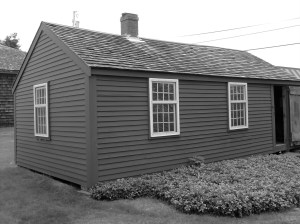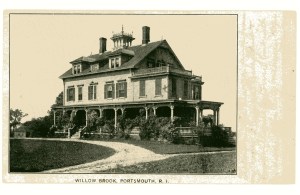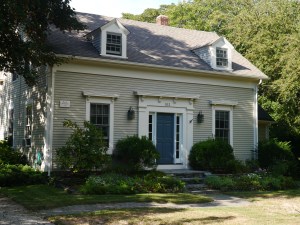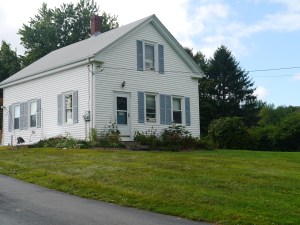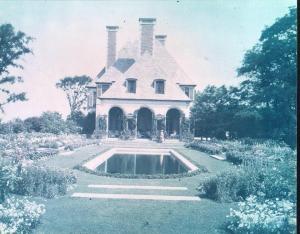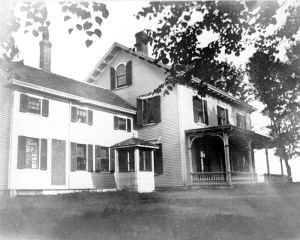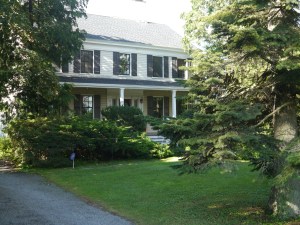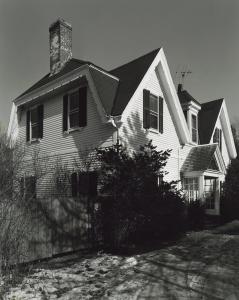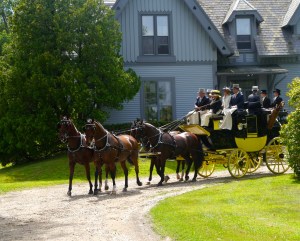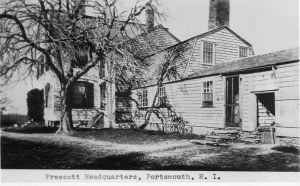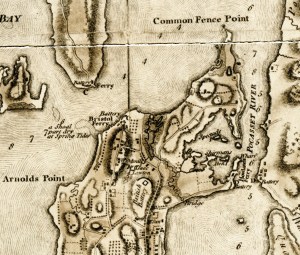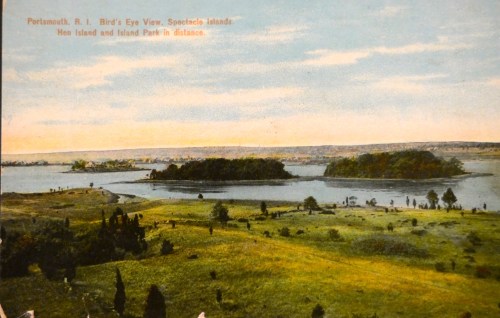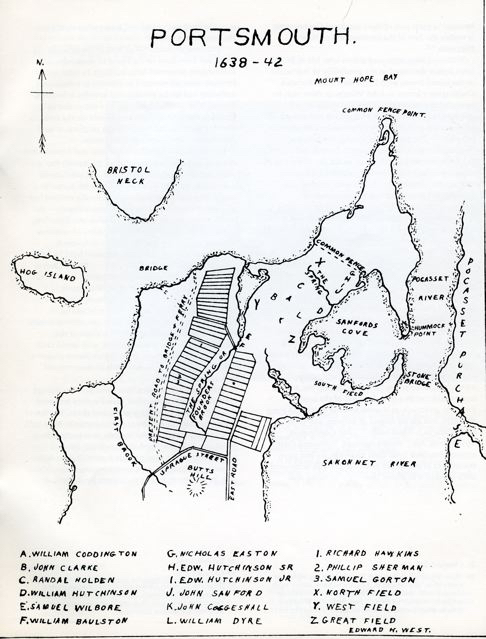Living in a School House?
Can you imagine a family living in the basement of a school? Two families did live in the “cellar” of the old Southermost School because they fell on hard times. We learn about these families from Portsmouth historian Edward West’s writings. In his 1932 article for the Rhode Island Historical Society on the “Lands of Portsmouth,” West gives a virtual tour of early Portsmouth. “..we come to the site of the Southern School House, where the widow Sarah Strange took up her residence after the death of her husband; for at a Town Meeting in 1746, she and her family were ordered out, so that the school house might be improved in the use for which it was built.”
Sarah’s situation is indeed “strange” because her family forced the move of another family to the cellar of the same school. Schoolmaster James Preston was reported as being sick and helpless in 1727. In the early days it was the families of the school children that were responsible for the room and board of the schoolmaster and his family. In an article on “Relief Problems of Old New England,” West reports on Portsmouth Town Council decisions. “James Strange (Sarah’s husband) refuses to entertain James Preston and his family any longer in his dwelling house it is agreed by this council that said Preston and his family be settled in the Southermost School house in the town for the present, that is in the cellar part thereof…” The Town Council agreed to pay Preston’s wife money weekly to provide for the family. Now the building at that time was twenty-two feet by fourteen feet – not large at all to house a family and the school children.
In 1730 it was ordered “that James Preston and his family be removed out of the School house wherein they now dwell and that Rebecca his wife pay the charges of their removal and house rent out of the weekly allowance.” Rebecca was forced to “bind out her two eldest children otherwise the said council will put out the said Children in order for the lessening the Towns Charges therein.” Soon afterwards James Preston died and the town paid his funeral charges. There is no further mention of the family in town records.
This schoolhouse is on the National Register of Historic Places.
Willow Brook
Connors Funeral Home today
This home has had some colorful owners and uses through the years. Researching the homes and dating them is always difficult. We think the house may date to around 1850 and it was built for David Anthony. Asa Anthony owned it when he served as Portsmouth Coroner in the 1880’s. Newspaper articles mention that sometimes bodies were brought to Asa’s home before burial. In 1898 after Asa’s death, the home and farm was sold at auction to the Ballou family of Providence who had a home down the road on Bristol Ferry. Newspaper articles state that they probably would not be living there. Perhaps they bought it for artist Sarah Eddy who used it as a place her friends and other artists could come and stay while visiting Portsmouth. 1907 maps show it as her property at that time. The image above was scanned from a glass plate and we suspect that Sarah Eddy – a noted photographer – may have taken this photograph. In 1900 the Rev. Dennis and his sister seemed to run the guest house. Newspaper articles show that Rev. Dennis ran a Sunday School there for children who weren’t members of any particular church. Grand parties were held for the community during the 1920’s including a Christmas party for 164 guests. The house became a “tourist lodge and trailer park” in the 1930’s after it was bought by a Mrs. Hollis. By 1958 we see ads for “Willow Brook Manor Nursing Home” In the 1970’s it seemed to by run by Leo MacAloon. For a while it was a nursery school. Memorial Funeral Home bought it in 1983 and has run it since then as a funeral home. It seems to be appropriate as the home of a former town coroner.
George Manchester House
102 Glen Road
George Manchester of Portsmouth, RI was born 1822, the son of John and Lydia (Albro) Manchester of 1105 East Main Rd. His brothers were John Henry Manchester and Daniel Manchester, both of Slate Hill, and his sisters were Susan and Rebecca (Mrs. William H. Gifford). George was a carpenter who helped construct many homes in Newport County. He was a devoted member of the Union Church at the location of today’s Portsmouth Historical Society, and taught Sunday School there. He was a public servant who represented Portsmouth in the RI General Assembly for several terms, as had his father and his grandfather Giles Manchester. At various times George held the offices of Superintendent of Public Schools in Portsmouth, State Railroad Commissioner, State Auditor, Customs Officer, Justice of the Peace, and High Sheriff of Newport County. An avid reader and book collector, he wrote book reviews and articles for magazines such as Harper’s, and for religious publications such as the Herald of Gospel Liberty and the Christian Inquirer. He lived at 102 Glen Rd., and was married to Phebe Taber Coggeshall. They had three children, Alfred (grew up to be a minister in Salem, MA), Charles (owned a store in Newport), and Leonora (wife of George Brawley, a Middletown farmer). George’s wife Phebe died in 1861. In 1873, he married Eliza Maria (Peckham) Rogers, widow of Thomas G. Rogers. George died in 1879 and is buried in St. Mary’s Church cemetery.
Cundall House – Maybe
Glen Farm Road
There are no definite dates for this house. 1798 is one date given. If so, than it would have been the home of Joseph Cundall, a notable miller in the area. Other sources note that this was the land of Joseph Cundall, but that the house was built later. This house, however, is known as the “Cundall House” in newspaper articles.
The Glen’s first settlers, the Cooke family, gradually moved away and sold their land, but many of the Cooke daughters married into local families. It is hard to trace all the ownership of what is now the town owned Glen land, but we did discover information on some of those landowners. In 1720 John Cooke sold a portion of his land to James Sisson. By 1745 Sisson had a water powered grist mill on the brook in the Glen to grind corn. Revolutionary War era maps show the location of that mill as just east of Glen Farm Road and the barn complex.
James Sisson then sold his mill and 46 acres around the brook to Joseph Cundall. What we call “the Glen” became commonly known as Cundall’s Mills. In 1706 Joseph Cundall had left his native England to become an indentured servant in America. Becoming an indentured servant was a way for a young person to learn a trade and get an education in exchange for working for seven years or more. Cundall seems to have learned his trade well and was in a good position to buy land as an adult. Water from the stream powered the carding and fulling mills to wash and pull woolen fibers. Joseph Cundall added almost a hundred more acres to his land around the Glen before he died in 1760. Newspaper accounts tell the tragic story of his son Joseph who got lost in a Christmas Eve snowstorm and died on his way home from the mill. Near the Glen barns there is a little burial ground with Slocum and Cundall family headstones. His gravestone is easily read in the old cemetery with a death date of December 24, 1811. If the 1790 date is accurate, this little house would have been home to this Joseph Cundall.
Mrs. Taylor’s Manor House
Frank Coelho Drive
Mrs. Taylor’s Manor House
Even though the Taylor family started Glen Farm in 1882, construction did not begin on their home until around 1920. The Taylors had a Newport summer home, but that preferred the Portsmouth countryside. They hired famed architect John Russell Pope to design their home in the Glen area. During World War I the Taylors lost their son in France. Family stories relate that the French chateau style of the home was designed to remember the place where their son died. The house was completed in 1923.
Architect Pope encouraged the Taylors to hire the Olmsted Brothers Firm to design the landscaping. The gardens were designed to be at their best in July and August when the family would be in residence. Mrs Taylor opened the grounds and gardens to special events. Moses Taylor died in 1928 but Edith continued to spend more time at the Glen. She remarried many years later and became Mrs. G.J. Guthrie Nicholson, but continued to come to the Manor House until her death in 1959.
In 1960 the Manor House and 43 acres around it were sold to the Elmhurst Academy of the Sacred Heart. The house served as a dormitory for boarding students. When Elmhurst Academy closed its doors in 1972, the Town of Portsmouth bought the house and the newly built school buildings that were attached to it.
Portsmouth citizens still own the house and the Glen Manor Authority and the Friends of Glen Manor House constantly strive to restore the house and gardens.
Leonard Brown House
Linden Lane
If you are familiar with the Glen, you may know that the Leonard Brown House sits at the end of a drive lined by majestic linden trees. Who’s was Leonard Brown and what does he represent in Portsmouth history. Brown was born in Middletown in 1815. His wife Sarah was the daughter of Revolutionary War militia leader Cook Wilcox. What would become the Brown farm had been part of Wilcox’s land. By the 1880s Brown was considered one of the best farmers in Portsmouth. He raised poultry and pigs and brought them to market in New Bedford. Along with farming, Brown served as a wheelwright and a blacksmith. Leonard Brown represents the Yankee farmers, the descendants of the original English settlers. Brown and the farmers like him were the backbone of Portsmouth. They served in political offices, farmed and were the skilled craftsmen of the town.
Dating the Brown House has been difficult. The diary of George Manchester shows that Brown was on the land in 1851 because a barn was built for him by Albert Coggeshall. 1860 maps show Leonard Brown on the property.
When Leonard Brown died in 1896, the Brown farm was sold to H.A.C. Taylor and became part of the Glen Farm. A 1904 gardening magazine shows that Taylor had the row of linden trees planted as a entryway to the house. The house served as a home for many Glen Farm families over the years. When the Town of Portsmouth bought the land in 1989, the Brown House was in disrepair. Fires, hurricanes and vandalism had damaged the house, but efforts are being made to restore and the use the house once more.
Mrs. Durfee’s Tea House
82 Glen Road
A 1893 Harper’s Monthly Magazine called Mrs. Durfee the “Goddess of the Glen.” No trip out to the romanic Glen was complete without stopping at the Durfee house for refreshments. Many of the Newport society greats would host dinners and events at the Durfee Tea House. One guest describes a visit in the 1870 timeframe: Miss Durfee, very lame but most hospitable, received her guests and soon the famous tea-house cakes were served. These were meal cakes, made as thin as a wafer, slightly sweetened with a suspicion of nutmeg flavor. Baked on a griddle that covered the whole top of the stove, they were compounded of a milk mixture consisting of ten eggs to a quart of milk, the finest Rhode Island meal, butter, sugar and spice….After supper, the frolic terminated in a Virginia Reel, in which all, young or old took part, and then the resellers returned home by the light of the moon.” (Newport Historical Society Bulletin, April 1926).
This house has had several owners and at least two locations through the years. There are two Mrs. (or Miss) Durfees. Samuel Clerk who took over the Cundall Mills property sold the original lot without a house to Mrs. Mary G. Durfee. in 1836. The house must have been built shortly after the sale. Mary Durfee must have originated the tea house because when the property was sold to Ruth Durfee in 1857 it was already known as “Mrs. Durfee’s Tea House.” Durfee Tea House was a cultural center for Portsmouth. Many activities were held there including the original Sunday School for the Union Meetinghouse which was organized by social reformer Dorothea Dix.
In 1909 the house was moved to the current Glen Road location because H.A.C. Taylor purchased the lot and wanted the house moved off of his farm. Manton Chase bought the house at auction and moved it.
Julia Ward Howe’s Oak Glen
745 Union St.
In 1850, Dr. Samuel Howe bought a small cottage on the land around what is now Oak Glen. Howe’s wife, Julia Ward Howe, had Rhode Island roots and this cottage became their summer refuge from Boston. Howe was a pioneer in education of the handicapped and he and Julia were part of the effort to abolish slavery. Julia may be best known for writing the words to the “Battle Hymn of the Republic,” but she also wrote songs, poetry, plays and essays. Henry Wadsworth Longfellow, Oscar Wilde and other literary giants came to visit her at Oak Glen.
The Howes enlarged the home in the 1870’s, but the home was still centered around their growing family of six children. The additions to the home helped it become a gathering spot for local and national literary figures. When Samuel died in 1876, Julia continued to live at Oak Glen until her death there in 1910. Julia was occasionally ask to “supply the pulpit” at the Christian Union Church down the road. She was a noted speaker, writer and advocate for such causes as Women’s Suffrage and the International Peace Association.
Some of her furniture from Oak Glen was donated to the Portsmouth Historical Society and is featured in the Julia Ward Howe Room of the museum.
This home is on the National Register of Historic Places.
Greenvale – Barstow House
In 1863 J.S. Barstow, a China trade merchant, purchased land in Portsmouth to establish a “gentleman’s farm.” Barstow followed a formula for the how much of the land would be in gardens, orchards, livestock, etc. He was inspired by a book called Country Life by Copeland that describes the type of person (like Barstow) who would establish such a farm as a man who craves occupation as well as recreation. “Owners of country seats in America are generally men who have retired from active business… and have something to do and to think about those avoid the evil of mental inactivity.”
Barstow’s “Stick Style” home was designed by Boston architect Sturgess who also designed a stable and barn. At Barstow’s death the house and land passed to relatives and finally to niece Charlotte Parker and her husband Major General James Parker. When the Parkers retired in 1918, the came back to a property that had been neglected and revived the farm. The property is owned by members of the Parker family today and has been re-purposed as a Greenvale Vineyard. Although you can’t tour the Barstow house itself, you can visit the stables that have been restored and redesigned as a Wine Tasting House.
Nichols – Overing House – Prescott Farm
This house is known not for the importance of its owners, but for a daring deed in the Revolutionary War. It was probably built by Jonathan Nichols before 1750. The Nichols family owned it until 1765 when John Nichol’s widow sold to Peleg Thurston. A “mansion” is listed on the property as part of the land transfer. Both John and Jonathan Nichols served as Deputy Governor of the Colony of Rhode Island. Thurston was merchant who might have been involved in privateering. After Thurston’s death in 1770, his widow sold the property to Henry John Overing. Overing was a “sugar baker” who refined raw sugar into loaves. Overing was loyal to England and when the British invaded Aquidneck Island in 1776, Overing’s farm was a headquarters for General Richard Prescott. In July of 1777, American Col. Barton and his men silently rowed across to Portsmouth from Warwick. They overcame the sentry without a shot and captured General Prescott. Prescott later came back to the island. He was exchanged for a Col Lee – an American held by the British. The whole “caper” raised the spirits of the Americans.
Overing seems to have sailed for England in 1783. Overing’s wife kept the house until 1796. The house was sold to her son-in-law, Thomas Handy. He sold the house to the Briggs family in 1797, but Thomas and Mary Handy lived as tenants on the farm. The Briggs sold to Asher Robbins, and in 1803 it was sold to Benjamin Pages. There were other owners along the way. Bradford Norman picked up the property in 1927 and his daughter, Barbara Norman Cook (aka Kitty Mouse) owned the house until she sold it to the Doris Duke’s Newport Restoration Foundation in 1970.
